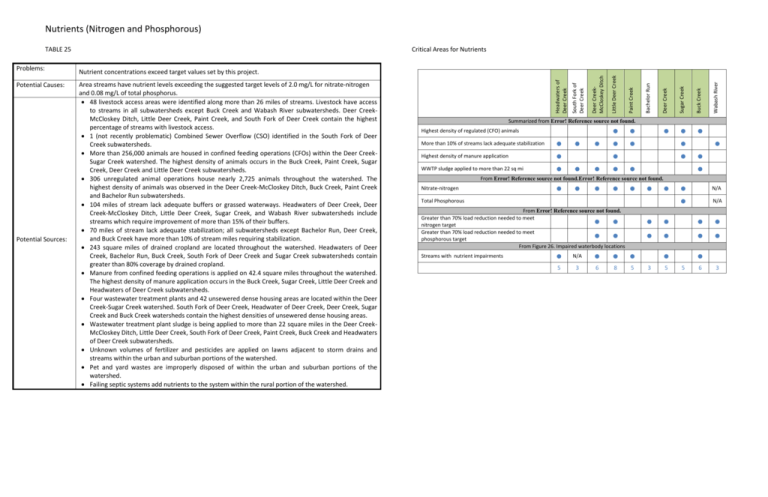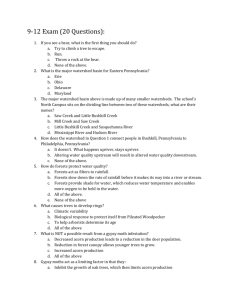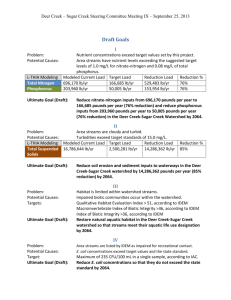Critical Areas Discussion
advertisement

Nutrients (Nitrogen and Phosphorous) Potential Sources: Sugar Creek Buck Creek ● ● ● ● ● Wabash River Deer Creek Bachelor Run Paint Creek Little Deer Creek Area streams have nutrient levels exceeding the suggested target levels of 2.0 mg/L for nitrate-nitrogen and 0.08 mg/L of total phosphorus. 48 livestock access areas were identified along more than 26 miles of streams. Livestock have access to streams in all subwatersheds except Buck Creek and Wabash River subwatersheds. Deer CreekMcCloskey Ditch, Little Deer Creek, Paint Creek, and South Fork of Deer Creek contain the highest percentage of streams with livestock access. 1 (not recently problematic) Combined Sewer Overflow (CSO) identified in the South Fork of Deer Creek subwatersheds. More than 256,000 animals are housed in confined feeding operations (CFOs) within the Deer CreekSugar Creek watershed. The highest density of animals occurs in the Buck Creek, Paint Creek, Sugar Creek, Deer Creek and Little Deer Creek subwatersheds. 306 unregulated animal operations house nearly 2,725 animals throughout the watershed. The highest density of animals was observed in the Deer Creek-McCloskey Ditch, Buck Creek, Paint Creek and Bachelor Run subwatersheds. 104 miles of stream lack adequate buffers or grassed waterways. Headwaters of Deer Creek, Deer Creek-McCloskey Ditch, Little Deer Creek, Sugar Creek, and Wabash River subwatersheds include streams which require improvement of more than 15% of their buffers. 70 miles of stream lack adequate stabilization; all subwatersheds except Bachelor Run, Deer Creek, and Buck Creek have more than 10% of stream miles requiring stabilization. 243 square miles of drained cropland are located throughout the watershed. Headwaters of Deer Creek, Bachelor Run, Buck Creek, South Fork of Deer Creek and Sugar Creek subwatersheds contain greater than 80% coverage by drained cropland. Manure from confined feeding operations is applied on 42.4 square miles throughout the watershed. The highest density of manure application occurs in the Buck Creek, Sugar Creek, Little Deer Creek and Headwaters of Deer Creek subwatersheds. Four wastewater treatment plants and 42 unsewered dense housing areas are located within the Deer Creek-Sugar Creek watershed. South Fork of Deer Creek, Headwater of Deer Creek, Deer Creek, Sugar Creek and Buck Creek watersheds contain the highest densities of unsewered dense housing areas. Wastewater treatment plant sludge is being applied to more than 22 square miles in the Deer CreekMcCloskey Ditch, Little Deer Creek, South Fork of Deer Creek, Paint Creek, Buck Creek and Headwaters of Deer Creek subwatersheds. Unknown volumes of fertilizer and pesticides are applied on lawns adjacent to storm drains and streams within the urban and suburban portions of the watershed. Pet and yard wastes are improperly disposed of within the urban and suburban portions of the watershed. Failing septic systems add nutrients to the system within the rural portion of the watershed. South Fork of Deer Creek Potential Causes: Nutrient concentrations exceed target values set by this project. Headwaters of Deer Creek Problems: Critical Areas for Nutrients Deer CreekMcCloskey Ditch TABLE 25 Summarized from Error! Reference source not found. Highest density of regulated (CFO) animals More than 10% of streams lack adequate stabilization Highest density of manure application WWTP sludge applied to more than 22 sq mi ● ● ● ● ● ● ● ● ● ● ● ● ● ● ● ● ● From Error! Reference source not found.Error! Reference source not found. Nitrate-nitrogen ● ● ● ● ● ● ● Total Phosphorous From Error! Reference source not found. Greater than 70% load reduction needed to meet nitrogen target Greater than 70% load reduction needed to meet phosphorous target From Figure 26. Impaired waterbody locations Streams with nutrient impairments ● ● ● ● ● ● ● N/A ● ● ● 5 3 6 8 5 3 ● ● N/A N/A ● ● ● ● ● ● 5 5 6 ● ● 3 Sediment Potential Sources: Wabash River Buck Creek Sugar Creek Deer Creek Bachelor Run Paint Creek 48 livestock access areas were identified along more than 26 miles of streams. Livestock have access to streams in all subwatersheds except Buck Creek and Wabash River subwatersheds. Deer Creek-McCloskey Ditch, Little Deer Creek, Paint Creek, and South Fork of Deer Creek contain the highest percentage of streams with livestock access. 104 miles of stream lack adequate buffers or grassed waterways. Headwaters of Deer Creek, Deer Creek-McCloskey Ditch, Little Deer Creek, Sugar Creek, and Wabash River subwatersheds include streams which require improvement of more than 15% of their buffers. 70 miles of stream lack adequate stabilization; all subwatersheds except Bachelor Run, Deer Creek, and Buck Creek have more than 10% of stream miles requiring stabilization. 243 square miles of drained cropland are located throughout the watershed. Headwaters of Deer Creek, Bachelor Run, Buck Creek, South Fork of Deer Creek and Sugar Creek subwatersheds contain greater than 80% coverage by drained cropland. Little Deer Creek Turbidities exceed target standards of 9.89 NTU. Deer CreekMcCloskey Ditch Potential Causes: Area streams are cloudy and turbid. Headwaters of Deer Creek Problems: Critical Areas for Sediment South Fork of Deer Creek Table 26 Summarized from Error! Reference source not found. More than 10% of streams lack adequate stabilization ● ● ● ● ● ● ● ● N/A From Error! Reference source not found.Error! Reference source not found. Sediment ● ● ● ● From Error! Reference source not found. Greater than 85% load reduction needed to meet sediment target ● 2 2 2 3 1 ● ● ● ● 2 2 2 ● ● 1 2 E. coli Potential Sources: Sugar Creek Buck Creek ● ● ● ● ● ● Wabash River Deer Creek 48 livestock access areas were identified along more than 26 miles of streams. Livestock have access to streams in all subwatersheds except Buck Creek and Wabash River subwatersheds. Deer Creek-McCloskey Ditch, Little Deer Creek, Paint Creek, and South Fork of Deer Creek contain the highest percentage of streams with livestock access. 1 (not recently problematic) Combined Sewer Overflow (CSO) identified in the South Fork of Deer Creek subwatersheds. Four wastewater treatment plants and 42 unsewered dense housing areas are located within the Deer Creek-Sugar Creek watershed. South Fork of Deer Creek, Headwater Deer Creek, Deer Creek, Sugar Creek and Buck Creek watersheds contain the highest densities of unsewered dense housing areas. More than 256,000 animals are housed on confined feeding operations (CFOs) within the Deer CreekSugar Creek watershed. The highest density of animals occurs in the Buck Creek, Paint Creek, Sugar Creek, Deer Creek and Little Deer Creek subwatersheds. 306 unregulated animal operations house nearly 2,725 animals throughout the watershed. The highest density of animals was observed in the Deer Creek-McCloskey Ditch, Buck Creek, Paint Creek and Bachelor Run subwatersheds. 104 miles of stream lack adequate buffers or grassed waterways. Headwaters of Deer Creek, Deer CreekMcCloskey Ditch, Little Deer Creek, Sugar Creek, and Wabash River subwatersheds include streams which require improvement of more than 15% of their buffers. 70 miles of stream lack adequate stabilization; all subwatersheds except Bachelor Run, Deer Creek, and Buck Creek have more than 10% of stream miles requiring stabilization. Manure from confined feeding operations is applied on 42.4 square miles throughout the watershed. The highest density of manure application occurs in the Buck Creek, Sugar Creek, Little Deer Creek and Headwaters of Deer Creek subwatersheds. Wastewater treatment plant sludge is being applied to more than 22 square miles in the Deer CreekMcCloskey Ditch, Little Deer Creek, South Fork of Deer Creek, Paint Creek, Buck Creek and Headwaters of Deer Creek subwatersheds. Failing septic systems add nutrients to waterbodies within the rural portion of the watershed. Bachelor Run E. coli concentrations exceed target values and the state standard. Paint Creek Potential Causes: Little Deer Creek Area streams are listed by IDEM as impaired for recreational contact. Deer CreekMcCloskey Ditch Problems: South Fork of Deer Creek Critical Areas for E. coli Headwaters of Deer Creek TABLE 28 Summarized from Error! Reference source not found. Highest density of regulated (CFO) animals Highest density of manure application WWTP sludge applied to more than 22 sq mi ● ● ● ● ● ● ● ● ● From Error! Reference source not found.Error! Reference source not found. E. coli ● ● ● ● ● ● ● ● N/A From Figure 26. Impaired waterbody locations Streams with E. coli impairments ● N/A ● ● ● ● ● ● ● ● 4 2 3 5 4 2 3 4 4 1






